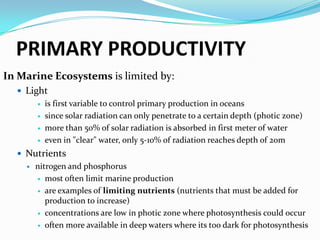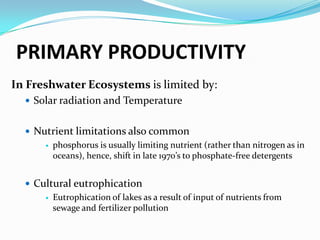Aquatic biomes
- 1. AQUATIC BIOMESThe biosphere is that portion of Earth inhabited by life and represents the sum of all communities and ecosystems.A biome is a broad, regional type of ecosystem characterized by distinctive climate and soil conditions and a distinctive kind of biological community adapted to those conditions.
- 2. Aquatic Biomes account for the largest part of the biosphere in terms of area, and all types are found in the globe.Ecologists distinguish between freshwater biomes and marine biomes on the basis of their physical and chemical differences.Marine biomes generally have salt concentrations that average 3%, whereas freshwater biomes only have less than 1%.
- 4. Marine BiomesMany aquatic biomes are physically and chemically stratified for both a lake and marine environment. Vertical Stratification based on physical and chemical variables, such aslighttemperatureLight is absorbed by organisms and the water intensity decreases rapidly with deptTemperature light-penetrated layerwarmed by heat energy from sunlight2deep waters beyond penetration of lightare uniformly cold
- 5. The surface waters are warmer and the deeper ocean is colder. Between them is the thermocline which is a thin zone where temperature decreases rapidly with depth.
- 6. PRIMARY PRODUCTIVITYIn Marine Ecosystems is limited by:Light is first variable to control primary production in oceanssince solar radiation can only penetrate to a certain depth (photic zone)more than 50% of solar radiation is absorbed in first meter of watereven in "clear" water, only 5-10% of radiation reaches depth of 20mNutrientsnitrogen and phosphorusmost often limit marine productionare examples of limiting nutrients (nutrients that must be added for production to increase)concentrations are low in photic zone where photosynthesis could occuroften more available in deep waters where its too dark for photosynthesis
- 7. PRIMARY PRODUCTIVITYIn Freshwater Ecosystems is limited by:Solar radiation and TemperatureNutrient limitations also commonphosphorus is usually limiting nutrient (rather than nitrogen as in oceans), hence, shift in late 1970’s to phosphate-free detergentsCultural eutrophicationEutrophication of lakes as a result of input of nutrients from sewage and fertilizer pollution
- 8. THE FRESHWATER BIOMES 1. Standing (Lentic) Bodies of WaterLakes and PondsWetlands 2. Moving (Lotic) Bodies of WaterRivers and Streams
- 9. THE MARINE BIOMESMarine biomes include three categories: 1) Oceans 2) Coral reefs3) Estuaries
- 10. THE DISTRIBUTION OF MAJOR AQUATIC BIOMES








